A 22-Site Comparison of Land-Use Practices, E-coli and Enterococci Concentrations
Abstract
:1. Introduction
2. Materials and Methods
2.1. Study Site Description
2.2. Data Collection
2.3. Data Analysis
3. Results
3.1. Climate during Study
3.2. Escherichia Coli and Enterococci Concentrations
3.3. pH Results
3.4. Multivariate Statistical Results
4. Discussion
4.1. Escherichia coli and Enterococci Concentrations, pH, and Land Use Practices
4.2. Study Implications and Future Work
5. Conclusions
Author Contributions
Funding
Institutional Review Board Statement
Informed Consent Statement
Data Availability Statement
Acknowledgments
Conflicts of Interest
Appendix A
| E-coli—Site Number | |||||||||||
| Site #1 | Site #2 | Site #3 | Site #4 | Site #5 | Site #6 | Site #7 | Site #8 | Site #9 | Site #10 | Site #11 | |
| Mean | 176 | 288 | 411 | 269 | 15 | 268 | 348 | 1027 | 348 | 294 | 56 |
| Median | 31 | 18 | 365 | 291 | 12 | 78 | 49 | 1046 | 51 | 79 | 16 |
| Minimum | 5 | 0 | 16 | 41 | 0 | 31 | 0 | 73 | 3 | 11 | 0 |
| Maximum | 613 | 2420 | 1203 | 687 | 57 | 1414 | 1986 | 2420 | 2420 | 1553 | 326 |
| Std Dev | 232 | 754 | 354 | 211 | 18 | 415 | 613 | 929 | 739 | 475 | 98 |
| E-coli—Site Number | |||||||||||
| Site #12 | Site #13 | Site #14 | Site #15 | Site #16 | Site #17 | Site #18 | Site #19 | Site #20 | Site #21 | Site #22 | |
| Mean | 345 | 115 | 820 | 622 | 849 | 110 | 524 | 837 | 703 | 727 | 476 |
| Median | 17 | 59 | 411 | 308 | 221 | 94 | 291 | 649 | 228 | 219 | 172 |
| Minimum | 4 | 13 | 14 | 84 | 66 | 10 | 8 | 127 | 64 | 108 | 141 |
| Maximum | 2420 | 548 | 2420 | 2420 | 2420 | 272 | 2420 | 2420 | 2420 | 2420 | 2420 |
| Std Dev | 746 | 158 | 900 | 727 | 967 | 97 | 744 | 767 | 927 | 919 | 700 |
| Enterococci—Site Number | |||||||||||
| Site #1 | Site #2 | Site #3 | Site #4 | Site #5 | Site #6 | Site #7 | Site #8 | Site #9 | Site #10 | Site #11 | |
| Mean | 154 | 3 | 154 | 463 | 1 | 70 | 32 | 6 | 1 | 2 | 31 |
| Median | 32 | 1 | 22 | 147 | 0 | 15 | 7 | 0 | 1 | 1 | 3 |
| Minimum | 0 | 0 | 0 | 1 | 0 | 0 | 0 | 0 | 0 | 0 | 0 |
| Maximum | 816 | 15 | 1203 | 1986 | 5 | 387 | 249 | 37 | 6 | 8 | 231 |
| Std Dev | 254 | 4 | 372 | 644 | 2 | 120 | 77 | 11 | 2 | 2 | 71 |
| Enterococci—Site Number | |||||||||||
| Site #12 | Site #13 | Site #14 | Site #15 | Site #16 | Site #17 | Site #18 | Site #19 | Site #20 | Site #21 | Site #22 | |
| Mean | 36 | 25 | 975 | 1358 | 1555 | 538 | 251 | 695 | 873 | 792 | 339 |
| Median | 1 | 1 | 921 | 1553 | 1643 | 459 | 20 | 276 | 411 | 548 | 179 |
| Minimum | 0 | 0 | 5 | 55 | 435 | 29 | 1 | 102 | 81 | 29 | 20 |
| Maximum | 308 | 214 | 2420 | 2420 | 2420 | 1203 | 921 | 1733 | 2420 | 2420 | 1120 |
| Std Dev | 96 | 67 | 945 | 1037 | 874 | 466 | 363 | 630 | 910 | 761 | 339 |
| Site Number | |||||||||||
| Site #1 | Site #2 | Site #3 | Site #4 | Site #5 | Site #6 | Site #7 | Site #8 | Site #9 | Site #10 | Site #11 | |
| Mean | 6.4 | 5.7 | 6.3 | 6.8 | 5.5 | 6.4 | 4.8 | 4.1 | 4.7 | 5.3 | 5.5 |
| Median | 6.4 | 6.0 | 6.3 | 6.8 | 6.7 | 6.8 | 4.9 | 4.0 | 4.7 | 5.3 | 5.6 |
| Minimum | 5.9 | 4.5 | 5.8 | 6.3 | 2.8 | 5.3 | 2.9 | 3.1 | 3.3 | 3.8 | 3.7 |
| Maximum | 7.3 | 6.6 | 6.8 | 7.3 | 7.3 | 7.4 | 6.9 | 6.7 | 7.0 | 7.0 | 6.7 |
| Std Dev | 0.3 | 0.7 | 0.3 | 0.2 | 1.7 | 0.6 | 1.5 | 0.8 | 1.0 | 0.7 | 0.7 |
| Site Number | |||||||||||
| Site #12 | Site #13 | Site #14 | Site #15 | Site #16 | Site #17 | Site #18 | Site #19 | Site #20 | Site #21 | Site #22 | |
| Mean | 4.1 | 5.1 | 6.0 | 7.1 | 7.5 | 7.6 | 7.0 | 7.3 | 7.9 | 7.9 | 7.9 |
| Median | 3.5 | 5.0 | 6.0 | 7.1 | 7.6 | 7.7 | 7.2 | 7.4 | 7.8 | 8.0 | 7.9 |
| Minimum | 2.8 | 3.9 | 5.0 | 6.6 | 6.6 | 7.1 | 5.3 | 6.1 | 7.0 | 7.4 | 7.5 |
| Maximum | 6.5 | 6.8 | 7.0 | 8.7 | 8.2 | 8.1 | 7.7 | 7.9 | 8.9 | 8.4 | 8.3 |
| Std Dev | 1.2 | 0.8 | 0.4 | 0.4 | 0.4 | 0.3 | 0.6 | 0.4 | 0.4 | 0.3 | 0.2 |
| E. coli Avg. | E. coli Med. | E. coli Std. Dev. | E. coli Max. | E. coli Min. | Entero Avg. | Entero Med. | Entero Std. Dev. | Entero Max. | Entero Min. | pH | Mixed Dev. | Ag | Forest | ||
|---|---|---|---|---|---|---|---|---|---|---|---|---|---|---|---|
| E. coli Avg. | SCC | 1 | |||||||||||||
| E. coli Avg. | p-value | -- | |||||||||||||
| E. coli Med. | SCC | 0.761 | 1 | ||||||||||||
| E. coli Med. | p-value | 0.000 | -- | ||||||||||||
| E. coli Std. Dev. | SCC | 0.893 | 0.498 | 1 | |||||||||||
| E. coli Std. Dev. | p-value | 0.000 | 0.018 | -- | |||||||||||
| E. coli Max. | SCC | 0.836 | 0.446 | 0.913 | 1 | ||||||||||
| E. coli Max. | p-value | 0.000 | 0.038 | 0.000 | -- | ||||||||||
| E. coli Min. | SCC | 0.659 | 0.761 | 0.460 | 0.436 | 1 | |||||||||
| E. coli Min. | p-value | 0.001 | 0.000 | 0.031 | 0.042 | -- | |||||||||
| Entero Avg. | SCC | 0.540 | 0.594 | 0.408 | 0.356 | 0.648 | 1 | ||||||||
| Entero Avg. | p-value | 0.009 | 0.004 | 0.059 | 0.104 | 0.001 | -- | ||||||||
| Entero Med. | SCC | 0.450 | 0.514 | 0.305 | 0.271 | 0.586 | 0.964 | 1 | |||||||
| Entero Med. | p-value | 0.036 | 0.014 | 0.167 | 0.222 | 0.004 | 0.000 | -- | |||||||
| Entero Std. Dev. | SCC | 0.513 | 0.632 | 0.357 | 0.308 | 0.627 | 0.981 | 0.936 | 1 | ||||||
| Entero Std. Dev. | p-value | 0.015 | 0.002 | 0.102 | 0.164 | 0.002 | 0.000 | 0.000 | -- | ||||||
| Entero Max. | SCC | 0.539 | 0.624 | 0.393 | 0.332 | 0.660 | 0.982 | 0.945 | 0.992 | 1 | |||||
| Entero Max. | p-value | 0.010 | 0.002 | 0.071 | 0.131 | 0.001 | 0.000 | 0.000 | 0.000 | -- | |||||
| Entero Min. | SCC | 0.558 | 0.570 | 0.453 | 0.417 | 0.671 | 0.880 | 0.861 | 0.827 | 0.832 | 1 | ||||
| Entero Min. | p-value | 0.007 | 0.006 | 0.034 | 0.053 | 0.001 | 0.000 | 0.000 | 0.000 | 0.000 | -- | ||||
| pH | SCC | 0.285 | 0.374 | 0.202 | 0.180 | 0.606 | 0.801 | 0.834 | 0.764 | 0.790 | 0.833 | 1 | |||
| pH | p-value | 0.198 | 0.086 | 0.368 | 0.423 | 0.003 | 0.000 | 0.000 | 0.000 | 0.000 | 0.000 | -- | |||
| Mixed Dev. | SCC | 0.270 | 0.176 | 0.240 | 0.354 | 0.452 | 0.155 | 0.060 | 0.162 | 0.173 | 0.148 | 0.189 | 1 | ||
| Mixed Dev. | p-value | 0.223 | 0.433 | 0.282 | 0.106 | 0.035 | 0.490 | 0.792 | 0.471 | 0.441 | 0.511 | 0.399 | -- | ||
| Ag | SCC | −0.055 | −0.373 | −0.037 | −0.089 | −0.303 | −0.075 | −0.090 | −0.153 | −0.135 | −0.189 | −0.240 | −0.149 | 1 | |
| Ag | p-value | 0.809 | 0.088 | 0.871 | 0.694 | 0.171 | 0.740 | 0.689 | 0.497 | 0.550 | 0.399 | 0.282 | 0.510 | -- | |
| Forest | SCC | −0.231 | 0.092 | −0.260 | −0.267 | −0.229 | −0.312 | −0.224 | −0.254 | −0.262 | −0.289 | −0.254 | −0.673 | −0.391 | 1 |
| Forest | p-value | 0.301 | 0.684 | 0.242 | 0.230 | 0.305 | 0.157 | 0.317 | 0.255 | 0.239 | 0.192 | 0.255 | 0.001 | 0.072 | -- |
References
- Mara, D.; Lane, J.; Scott, B.; Trouba, D. Sanitation and health. PLoS Med. 2010, 7, e1000363. [Google Scholar] [CrossRef] [PubMed] [Green Version]
- Mukherjee, A.; Duttagupta, S.; Chattopadhyay, S.; Bhanja, S.N.; Bhattacharya, A.; Chakraborty, S.; Sarkar, S.; Ghosh, T.; Bhattacharya, J.; Sahu, S. Impact of sanitation and socio-economy on groundwater fecal pollution and human health towards achieving sustainable development goals across India from ground-observations and satellite-derived nightlight. Sci. Rep. 2019, 9, 15193. [Google Scholar] [CrossRef] [PubMed] [Green Version]
- Madoux-Humery, A.S.; Dorner, S.; Sauvé, S.; Aboulfadl, K.; Galarneau, M.; Servais, P.; Prévost, M. The effects of combined sewer overflow events on riverine sources of drinking water. Water Res. 2016, 92, 218–227. [Google Scholar] [CrossRef] [PubMed]
- CDC. E. coli (Escherichia coli). Centers for Disease Control and Prevention, National Center for Emerging and Zoonotic Infectious Diseases (NCEZID), Division of Foodborne, Waterborne, and Environmental Diseases (DFWED); CDC: Atlanta, GA, USA, 2020. [Google Scholar]
- Byappanahalli, M.N.; Roll, B.M.; Fujioka, R.S. Evidence for Occurrence, Persistence, and Growth Potential of Escherichia coli and Enterococci in Hawaii’s Soil Environments. Microbes Environ. 2012, 27, 164–170. [Google Scholar] [CrossRef] [Green Version]
- Petersen, F. Advancing Quantitative Understanding of Escherichia coli Concentrations in a Contemporary Mixed Land-Use Watershed, in West Virginia, USA. Ph.D. Thesis, West Virginia University, Morgantown, WV, USA, 2020. [Google Scholar]
- Petersen, F.; Hubbart, J.A. Physical Factors Impacting the Survival and Occurrence of Escherichia coli in Secondary Habitats. Water 2020, 12, 1796. [Google Scholar] [CrossRef]
- Ishii, S.; Sadowsky, M.J. Escherichia coli in the Environment: Implications for Water Quality and Human Health. Microbes Environ. 2008, 23, 101–108. [Google Scholar] [CrossRef] [Green Version]
- Desmarchelier, P.; Fegan, N. Pathogens in Milk: Escherichia coli, Reference Module in Food Science; Elsevier: Amsterdam, The Netherlands, 2016. [Google Scholar]
- Price, R.G.; Wildeboer, D. E. coli as an Indicator of Contamination and Health Risk in Environmental Waters; InTech: Vienna, Austria, 2017. [Google Scholar]
- Leimbach, A.; Hacker, J.; Dobrindt, U.E. coli as an all-rounder: The thin line between commensalism and pathogenicity. Curr. Top Microbiol. Immunol. 2013, 358, 3–32. [Google Scholar] [CrossRef]
- Nataro, J.P.; Kaper, J.B. Diarrheagenic Escherichia coli. Clin. Microbiol. Rev. 1998, 11, 142–201. [Google Scholar] [CrossRef] [Green Version]
- Kaper, J.B.; Nataro, J.P.; Mobley, H.L.T. Pathogenic Escherichia coli. Nat. Rev. Microbiol. 2004, 2, 123–140. [Google Scholar] [CrossRef]
- Murray, B.E. The life and times of the Enterococcus. Clin. Microbiol. Rev. 1990, 3, 46–65. [Google Scholar] [CrossRef]
- Hardie, J.M.; Whiley, R.A. Classification and overview of the genera Streptococcus and Enterococcus. J. Appl. Microbiol. 1997, 83, 1s–11s. [Google Scholar] [CrossRef] [PubMed]
- Giraffa, G. Enterococcus; Elsevier: Amsterdam, The Netherlands, 2014. [Google Scholar]
- Martin, J.D.; Mundt, J.O. Enterococci in insects. Appl. Microbiol. 1972, 24, 575–580. [Google Scholar] [CrossRef] [PubMed]
- Muller, T.; Ulrich, A.; Ott, E.M.; Muller, M. Identification of plant-associated enterococci. J. Appl. Microbiol. 2001, 91, 268–278. [Google Scholar] [CrossRef]
- Cabral, J.P.S. Water Microbiology. Bacterial Pathogens and Water. Int. J. Environ. Res. Public Health 2010, 7, 3657–3703. [Google Scholar] [CrossRef] [PubMed]
- Lattanzi, W.E.; Mood, E.W. A Comparison of Enterococci and E. coli as Indices of Water Pollution. Sew. Ind. Wastes 1951, 23, 1154–1160. [Google Scholar]
- Petersen, F.; Hubbart, J.A.; Kellner, E.; Kutta, E. Land-use-mediated Escherichia coli concentrations in a contemporary Appalachian watershed. Environ. Earth Sci. 2018, 77, 754. [Google Scholar] [CrossRef]
- Rwego, I.B.; Gillespie, T.R.; Isabirye-Basuta, G.; Goldberg, T.L. High Rates of Escherichia coli Transmission between Livestock and Humans in Rural Uganda. J. Clin. Microbiol. 2008, 46, 3187–3191. [Google Scholar] [CrossRef] [PubMed] [Green Version]
- Jamieson, R.; Joy, D.M.; Lee, H.; Kostaschuk, R.; Gordon, R. Transport and deposition of sediment-associated Escherichia coli in natural streams. Water Res. 2005, 39, 2665–2675. [Google Scholar] [CrossRef]
- Ostrolenk, M.; Kramer, N.; Cleverdon, R.C. Comparative Studies of Enterococci and Escherichia coli as Indices of Pollution. J. Bacteriol. 1947, 53, 197–203. [Google Scholar] [CrossRef] [Green Version]
- Stocker, M.D.; Pachepsky, Y.A.; Hill, R.L.; Shelton, D.R. Depth-Dependent Survival of Escherichia coli and Enterococci in Soil after Manure Application and Simulated Rainfall. Appl. Environ. Microbiol. 2015, 81, 4801–4808. [Google Scholar] [CrossRef] [Green Version]
- Anderson, S.A.; Turner, S.J.; Lewis, G.D. Enterococci in the New Zealand environment: Implications for water quality monitoring. Water Sci. Technol. 1997, 35, 325. [Google Scholar] [CrossRef]
- Badgley, B.D.; Nayak, B.S.; Harwood, V.J. The importance of sediment and submerged aquatic vegetation as potential habitats for persistent strains of enterococci in a subtropical watershed. Water Res. 2010, 44, 5857. [Google Scholar] [CrossRef] [PubMed]
- Badgley, B.D.; Thomas, F.I.; Harwood, V.J. The effects of submerged aquatic vegetation on the persistence of environmental populations of Enterococcus spp. Environ. Microbiol. 2010, 12, 1271–1281. [Google Scholar] [CrossRef] [PubMed]
- Bale, M.J.; Bennett, P.M.; Beringer, J.E.; Hinton, M. The survival of bacteria exposed to desiccation on surfaces associated with farm buildings. J. Appl. Bacteriol. 1993, 75, 519–528. [Google Scholar] [CrossRef] [PubMed]
- Neely, A.N.; Maley, M.P. Survival of Enterococci and Staphylococci on Hospital Fabrics and Plastic. J. Clin. Microbiol. 2000, 38, 724–726. [Google Scholar] [CrossRef] [PubMed] [Green Version]
- Whitman, R.L.; Shively, D.A.; Pawlik, H.; Nevers, M.B.; Byappanahalli, M.N. Occurrence of Escherichia coli and Enterococci in Cladophora (Chlorophyta) in Nearshore Water and Beach Sand of Lake Michigan. Appl. Environ. Microbiol. 2003, 69, 4714–4719. [Google Scholar] [CrossRef] [Green Version]
- Korajkic, A.; McMinn, B.R.; Harwood, V.J.; Shanks, O.C.; Fout, G.S.; Ashbolt, N.J. Differential decay of enterococci and Escherichia coli originating from two fecal pollution sources. Appl. Environ. Microbiol. 2013, 79, 2488–2492. [Google Scholar] [CrossRef] [Green Version]
- Paster, E.; Ryu, W.S. The thermal impulse response of Escherichia coli. Proc. Natl. Acad. Sci. USA 2008, 105, 5373–5377. [Google Scholar] [CrossRef] [Green Version]
- Rochelle-Newall, E.J.; Ribolzi, O.; Viguier, M.; Thammahacksa, C.; Silvera, N.; Latsachack, K.; Dinh, R.P.; Naporn, P.; Sy, H.T.; Soulileuth, B.; et al. Effect of land use and hydrological processes on Escherichia coli concentrations in streams of tropical, humid headwater catchments. Sci. Rep. 2016, 6, 32974. [Google Scholar] [CrossRef] [Green Version]
- Widgren, S.; Engblom, S.; Emanuelson, U.; Lindberg, A. Spatio-temporal modelling of verotoxigenic Escherichia coli O157 in cattle in Sweden: Exploring options for control. Vet. Res. 2018, 49, 78. [Google Scholar] [CrossRef] [Green Version]
- Hubbart, J.A.; Kellner, E.; Zeiger, S.J. A Case-Study Application of the Experimental Watershed Study Design to Advance Adaptive Management of Contemporary Watersheds. Water 2019, 11, 2355. [Google Scholar] [CrossRef]
- Petersen, F.; Hubbart, J.A. Quantifying Escherichia coli and Suspended Particulate Matter Concentrations in a Mixed-Land Use Appalachian Watershed. Water 2020, 12, 532. [Google Scholar] [CrossRef] [Green Version]
- Petersen, F.; Hubbart, J.A. Advancing Understanding of Land Use and Physicochemical Impacts on Fecal Contamination in Mixed-Land-Use Watersheds. Water 2020, 12, 1094. [Google Scholar] [CrossRef] [Green Version]
- Petersen, F.; Hubbart, J.A. Spatial and Temporal Characterization of Escherichia coli, Suspended Particulate Matter and Land Use Practice Relationships in a Mixed-Land Use Contemporary Watershed. Water 2020, 12, 1228. [Google Scholar] [CrossRef]
- Hewlett, J.D.; Lull, H.W.; Reinhart, K.G. In Defense of Experimental Watersheds. Water Resour. Res. 1969, 5, 306. [Google Scholar] [CrossRef]
- Leopold, L.B. Hydrologic research on instrumented watersheds. In Proceedings of the International Symposium on the Results of Research on Representative and Experimental Basins, Wellington, New Zealand, 1–8 December 1970; pp. 135–150. [Google Scholar]
- Bosch, J.; Hewlett, J. A review of catchment experiments to determine the effect of vegetation changes on water yield and evapotranspiration. J. Hydrol. 1982, 55, 3. [Google Scholar] [CrossRef]
- Zeiger, S.; Hubbart, J.A.; Anderson, S.H.; Stambaugh, M.C. Quantifying and modelling urban stream temperature: A central US watershed study. Hydrol. Process. 2016, 30, 503–514. [Google Scholar] [CrossRef]
- Nichols, J.; Hubbart, J.A.; Poulton, B.C. Using macroinvertebrate assemblages and multiple stressors to infer urban stream system condition: A case study in the central US. Urban Ecosyst. 2016, 19, 679–704. [Google Scholar] [CrossRef]
- Zeiger, S.J.; Hubbart, J.A. Nested-Scale Nutrient Flux in a Mixed-Land-Use Urbanizing Watershed. Hydrol. Process. 2016, 30, 1475–1490. [Google Scholar] [CrossRef]
- Tetzlaff, D.; Carey, S.K.; McNamara, J.P.; Laudon, H.; Soulsby, C. The essential value of long-term experimental data for hydrology and water management. Water Resour. Res. 2017, 53, 2598–2604. [Google Scholar] [CrossRef] [Green Version]
- Zeiger, S.J.; Hubbart, J.A. A SWAT model validation of nested-scale contemporaneous stream flow, suspended sediment and nutrients from a multiple-land-use watershed of the central USA. Sci. Total Environ. 2016, 572, 232–243. [Google Scholar] [CrossRef] [PubMed]
- Hubbart, J.A.; Kellner, E.; Hooper, L.W.; Zeiger, S. Quantifying loading, toxic concentrations, and systemic persistence of chloride in a contemporary mixed-land-use watershed using an experimental watershed approach. Sci. Total Environ. 2017, 581–582, 822–832. [Google Scholar] [CrossRef] [PubMed]
- Hubbart, J.A.; Muzika, R.-M.; Huang, D.; Robinson, A. Bottomland Hardwood forest influence on soil water consumption in an urban floodplain: Potential to improve flood storage capacity and reduce stormwater runoff. Watershed Sci. Bull. 2011, 3, 34–43. [Google Scholar]
- Cantor, J.; Krometis, L.-A.; Sarver, E.; Cook, N.; Badgley, B. Tracking the downstream impacts of inadequate sanitation in central Appalachia. J. Water Health 2017, 15, 580–590. [Google Scholar] [CrossRef] [Green Version]
- Dykeman, W. Appalachian Mountains; Encyclopedia Britannica: Chicago, IL, USA, 2020. [Google Scholar]
- USFS. Central Appalachian Broadleaf Forest (CABF)—Coniferous Forest—Meadow Province; United States Forest Service, US Department of Agriculture: Ogden, UT, USA, 2020. [Google Scholar]
- Koppen, W. Das Geographische System der Klimat; Handbuch der Klimatologie: Berlin, Germany, 1936; p. 46. [Google Scholar]
- Arcipowski, E.; Schwartz, J.; Davenport, L.; Hayes, M.; Nolan, T. Clean Water, Clean Life: Promoting Healthier, Accessible Water in Rural Appalachia. J. Contemp. Water Res. Educ. 2017, 161, 1–18. [Google Scholar] [CrossRef] [Green Version]
- Peel, M.C.; Finlayson, B.L.; McMahon, T.A. Updated world map of the Köppen-Geiger climate classification. Hydrol. Earth Syst. Sci. 2007, 11, 1633–1644. [Google Scholar] [CrossRef] [Green Version]
- Arguez, A.; Durre, I.; Applequist, S.; Squires, M.; Vose, R.; Yin, X.; Bilotta, R. NOAA’s U.S. Climate Normals (1981–2010); NOAA National Centers for Environmental Information: Silver Spring, MD, USA, 2010. [Google Scholar] [CrossRef]
- Kutta, E.; Hubbart, J. Climatic Trends of West Virginia: A Representative Appalachian Microcosm. Water 2019, 11, 1117. [Google Scholar] [CrossRef] [Green Version]
- Kutta, E.; Hubbart, J.A. Observed climatic changes in West Virginia and opportunities for agriculture. Reg. Environ. Chang. 2019, 19, 1087–1099. [Google Scholar] [CrossRef]
- Kutta, E.; Hubbart, J. Observed Mesoscale Hydroclimate Variability of North America’s Allegheny Mountains at 40.2° N. Climate 2019, 7, 91. [Google Scholar] [CrossRef] [Green Version]
- Kellner, E.; Hubbart, J.; Stephan, K.; Morrissey, E.; Freedman, Z.; Kutta, E.; Kelly, C. Characterization of sub-watershed-scale stream chemistry regimes in an Appalachian mixed-land-use watershed. Environ. Monit. Assess. 2018, 190, 586. [Google Scholar] [CrossRef]
- Horne, J.P.; Hubbart, J.A. A Spatially Distributed Investigation of Stream Water Temperature in a Contemporary Mixed-Land-Use Watershed. Water 2020, 12, 1756. [Google Scholar] [CrossRef]
- Hubbart, J.A.; Link, T.E.; Gravelle, J.A.; Elliot, W.J. Timber harvest impacts on water yield in the continental/maritime hydroclimatic region of the United States. For. Sci. 2007, 52, 169–180. [Google Scholar]
- Hubbart, J.A.; Holmes, J.; Bowman, G. TMDLs: Improving stakeholder acceptance with science-based allocations. Watershed Sci. Bull. 2010, 1, 19–24. [Google Scholar]
- Zeiger, S.J.; Hubbart, J.A. Quantifying flow interval–pollutant loading relationships in a rapidly urbanizing mixed-land-use watershed of the Central USA. Environ. Earth Sci. 2017, 76, 484. [Google Scholar] [CrossRef]
- Kellner, E.; Hubbart, J. Advancing Understanding of the Surface Water Quality Regime of Contemporary Mixed-Land-Use Watersheds: An Application of the Experimental Watershed Method. Hydrology 2017, 4, 31. [Google Scholar] [CrossRef] [Green Version]
- IDEXX. Laboratories Colilert Procedure Manual; IDEXX: Westbrook, ME, USA, 2020. [Google Scholar]
- Cummings, D. IDEXX, the Fecal Coliform Test Compared to Specific Tests for Escherichia coli; IDEXX: Westbrook, ME, USA,, 2020. [Google Scholar]
- Yazici, B.; Yolacan, S. A comparison of various tests of normality. J. Stat. Comput. Simul. 2007, 77, 175–183. [Google Scholar] [CrossRef]
- Fisher, R.A. Statistical Methods for Research Workers; Springer Series in Statistics; Springer: New York, NY, USA, 1992; pp. 66–70. [Google Scholar]
- Bro, R.; Smilde, A.K. Principal component analysis. Anal. Methods 2014, 6, 2812–2831. [Google Scholar] [CrossRef] [Green Version]
- Braak, C.J.F.T. Canonical Correspondence Analysis: A New Eigenvector Technique for Multivariate Direct Gradient Analysis. Ecology 1986, 67, 1167. [Google Scholar] [CrossRef] [Green Version]
- Braak, C.J.F.T. The Analysis of Vegetation-Environment Relationships by Canonical Correspondence Analysis. Vegetatio 1987, 69, 69–77. [Google Scholar] [CrossRef]
- USCD. United States Climate Data (USCD); USCD: Clifton Road Atlanta, GA, USA, 2020. [Google Scholar]
- Gotkowska-Płachta, A.; Gołaś, I.; Korzeniewska, E.; Koc, J.; Rochwerger, A.; Solarski, K. Evaluation of the distribution of fecal indicator bacteria in a river system depending on different types of land use in the southern watershed of the Baltic Sea. Environ. Sci. Pollut. Res. Int. 2016, 23, 4073–4085. [Google Scholar] [CrossRef]
- Moellering, R.C., Jr. Emergence of Enterococcus as a significant pathogen. Clin. Infect. Dis. 1992, 14, 1173–1176. [Google Scholar] [CrossRef]
- LindströM, E.S.; Kamst-Van Agterveld, M.P.; Zwart, G. Distribution of Typical Freshwater Bacterial Groups Is Associated with pH, Temperature, and Lake Water Retention Time. Appl. Environ. Microbiol. 2005, 71, 8201–8206. [Google Scholar] [CrossRef] [PubMed] [Green Version]
- Bååth, E.; Kritzberg, E. pH Tolerance in Freshwater Bacterioplankton: Trait Variation of the Community as Measured by Leucine Incorporation. Appl. Environ. Microbiol. 2015, 81, 7411–7419. [Google Scholar] [CrossRef] [PubMed]
- Roychowdhury, A.; Sarkar, D.; Datta, R. Removal of Acidity and Metals from Acid Mine Drainage-Impacted Water using Industrial Byproducts. Environ. Manag. 2019, 63, 148. [Google Scholar]
- Gray, N.F. Field assessment of acid mine drainage contamination in surface and ground water. Environ. Geol. 1996, 27, 358. [Google Scholar] [CrossRef]
- Sharma, S.; Lee, M.; Reinmann, C.S.; Pumneo, J.; Cutright, T.J.; Senko, J.M. Impact of acid mine drainage chemistry and microbiology on the development of efficient Fe removal activities. Chemosphere 2020, 249, 126117. [Google Scholar] [CrossRef]
- Tong, S.T.Y.; Chen, W. Modeling the relationship between land use and surface water quality. J. Environ. Manag. 2002, 66, 377–393. [Google Scholar] [CrossRef]
- Brown, T.; Binkley, D.; Brown, D. Water Quality on Forest Lands; Rocky Mountain Research Station: Fort Collins, CO, USA, 2020. [Google Scholar]
- Stein, E.D.; Tiefenthaler, L.L.; Schiff, K.C. Comparison of stormwater pollutant loading by land use type. South. Calif. Coast. Water Res. Proj. 2008 Annu. Rep. 2008, 3535, 15–27. [Google Scholar]
- Wu, J.; Yunus, M.; Islam, M.S.; Emch, M. Influence of Climate Extremes and Land Use on Fecal Contamination of Shallow Tubewells in Bangladesh. Environ. Sci. Technol. 2016, 50, 2669–2676. [Google Scholar] [CrossRef] [Green Version]
- Booth, D.B.; Roy, A.H.; Smith, B.; Capps, K.A. Global perspectives on the urban stream syndrome. Freshw. Sci. 2016, 35, 412–420. [Google Scholar] [CrossRef]
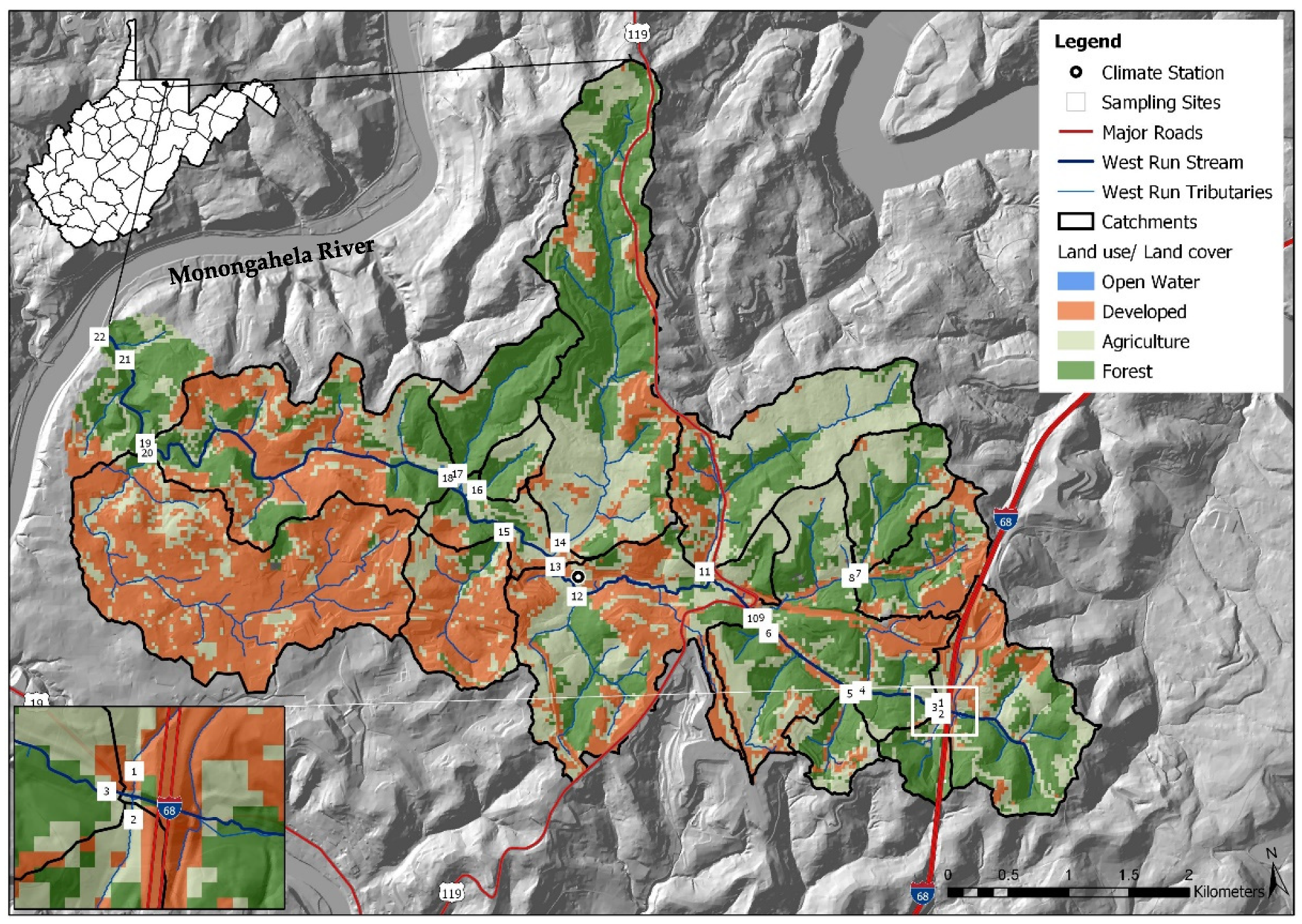


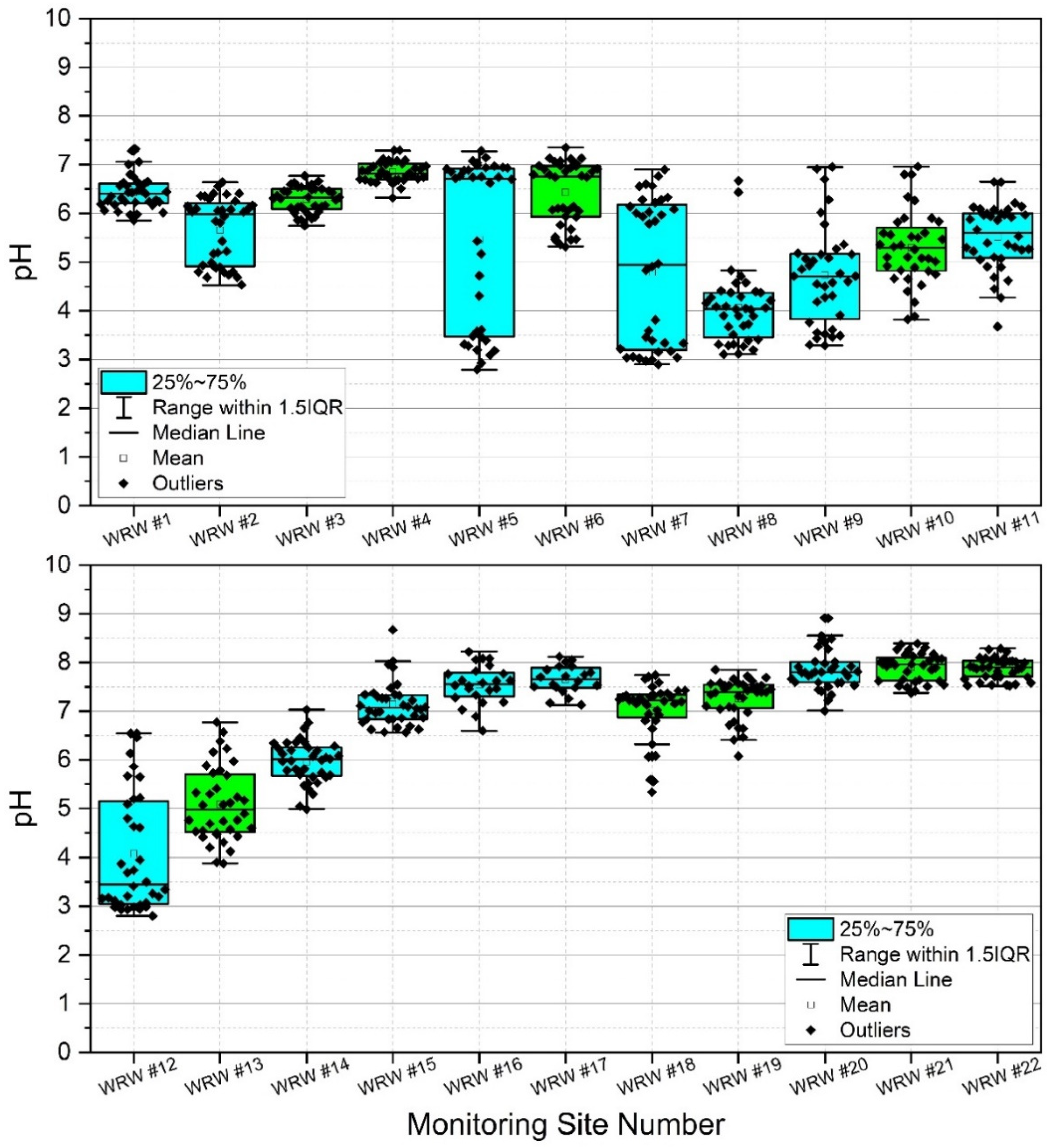
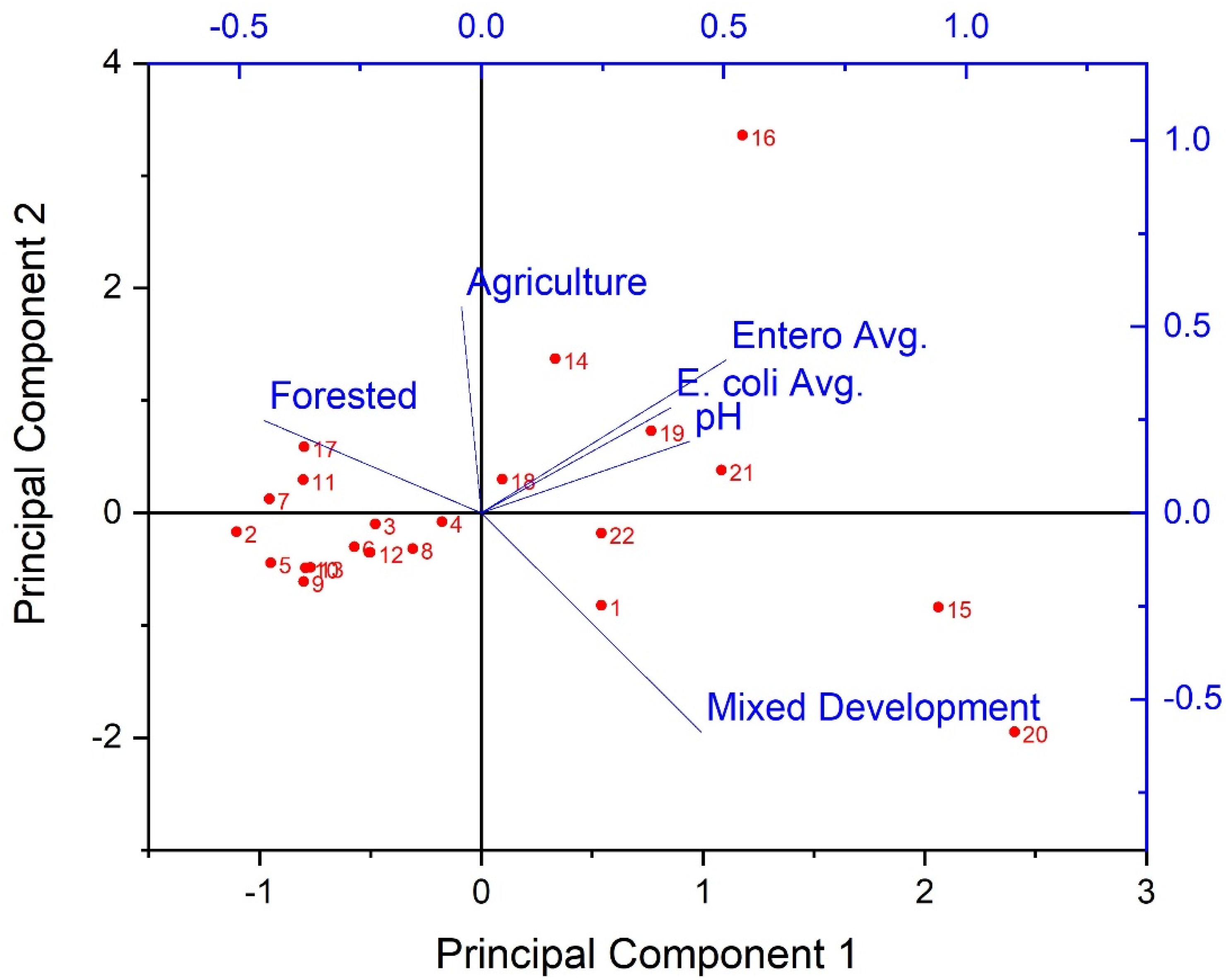
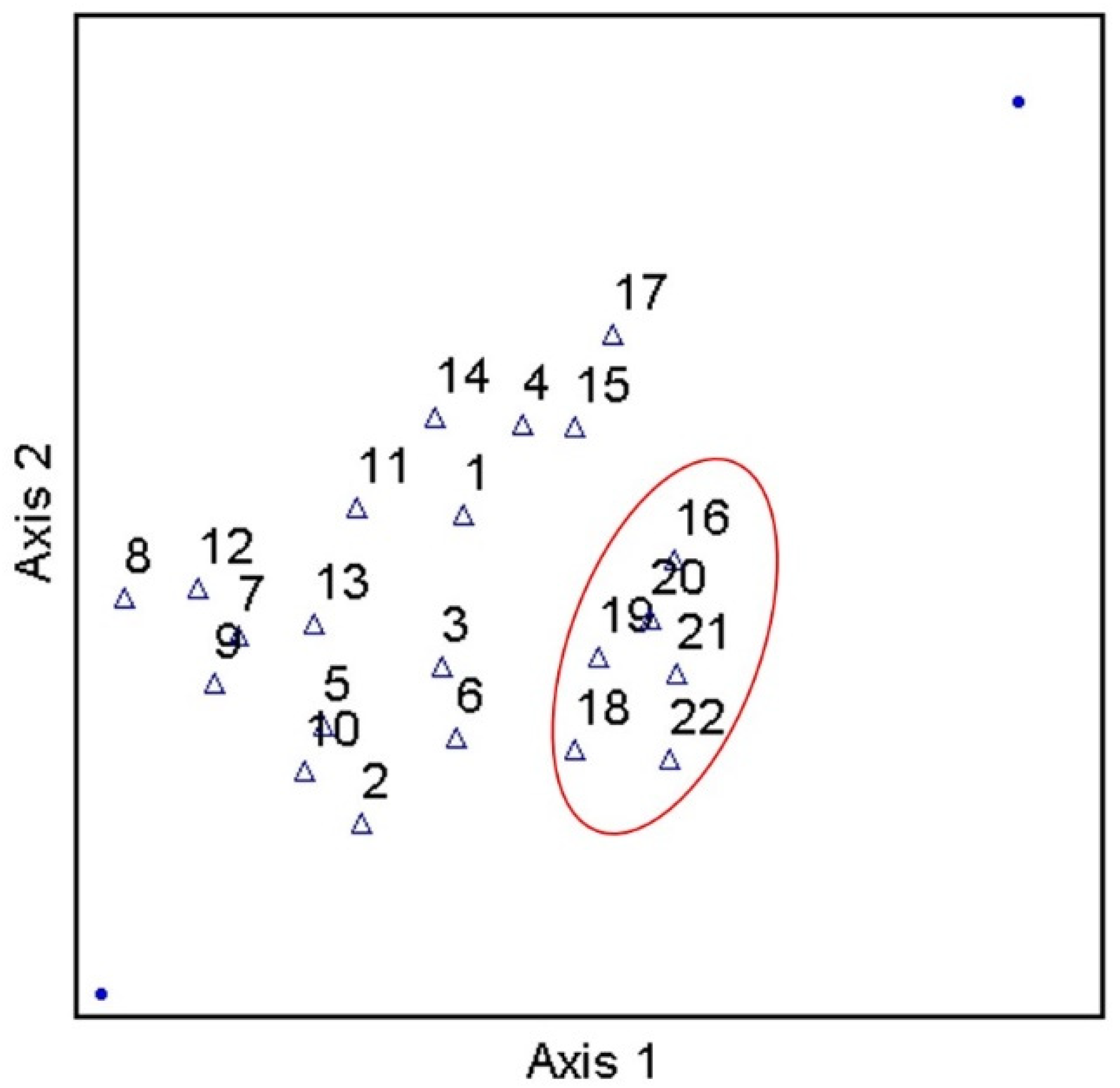
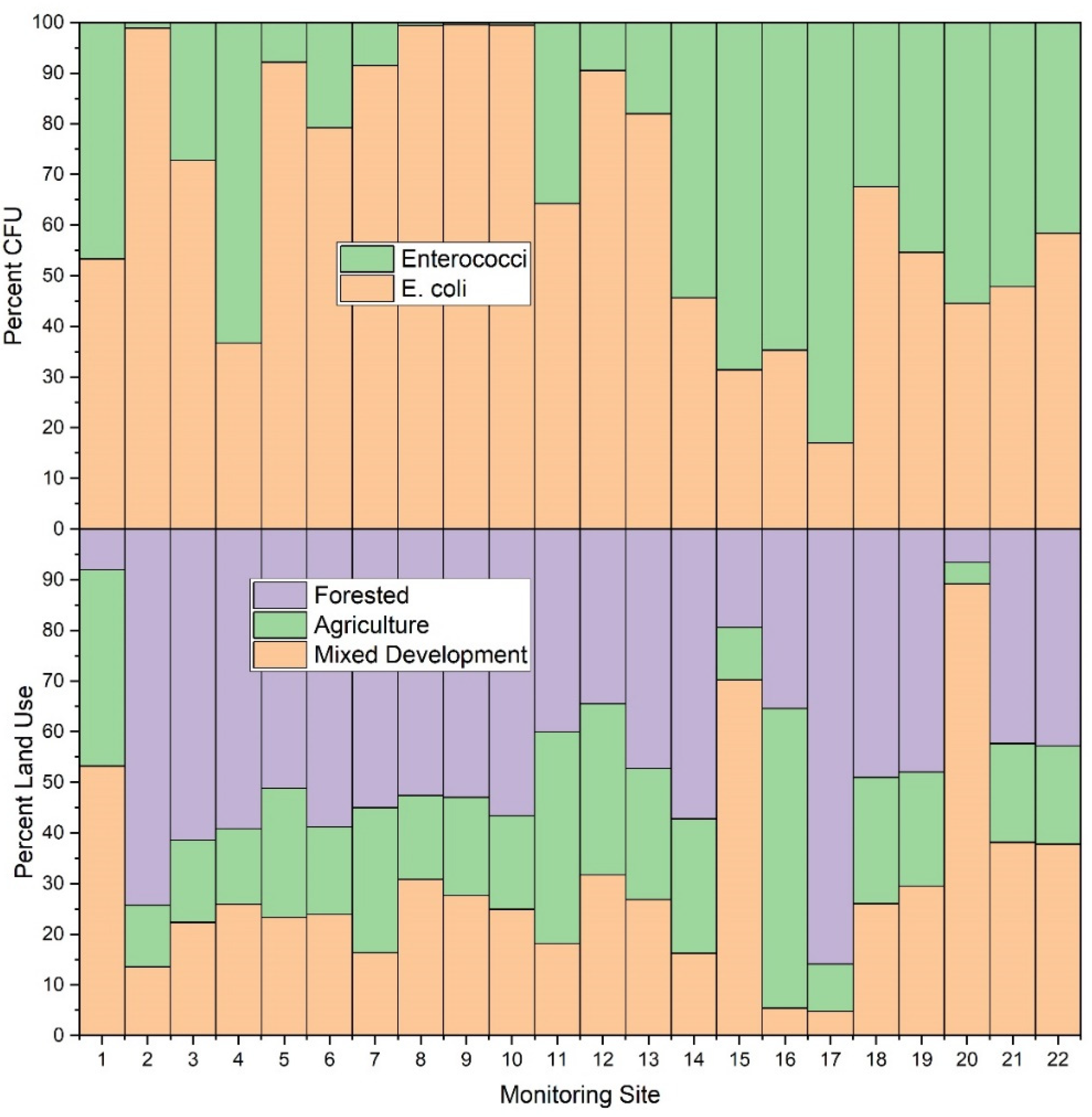
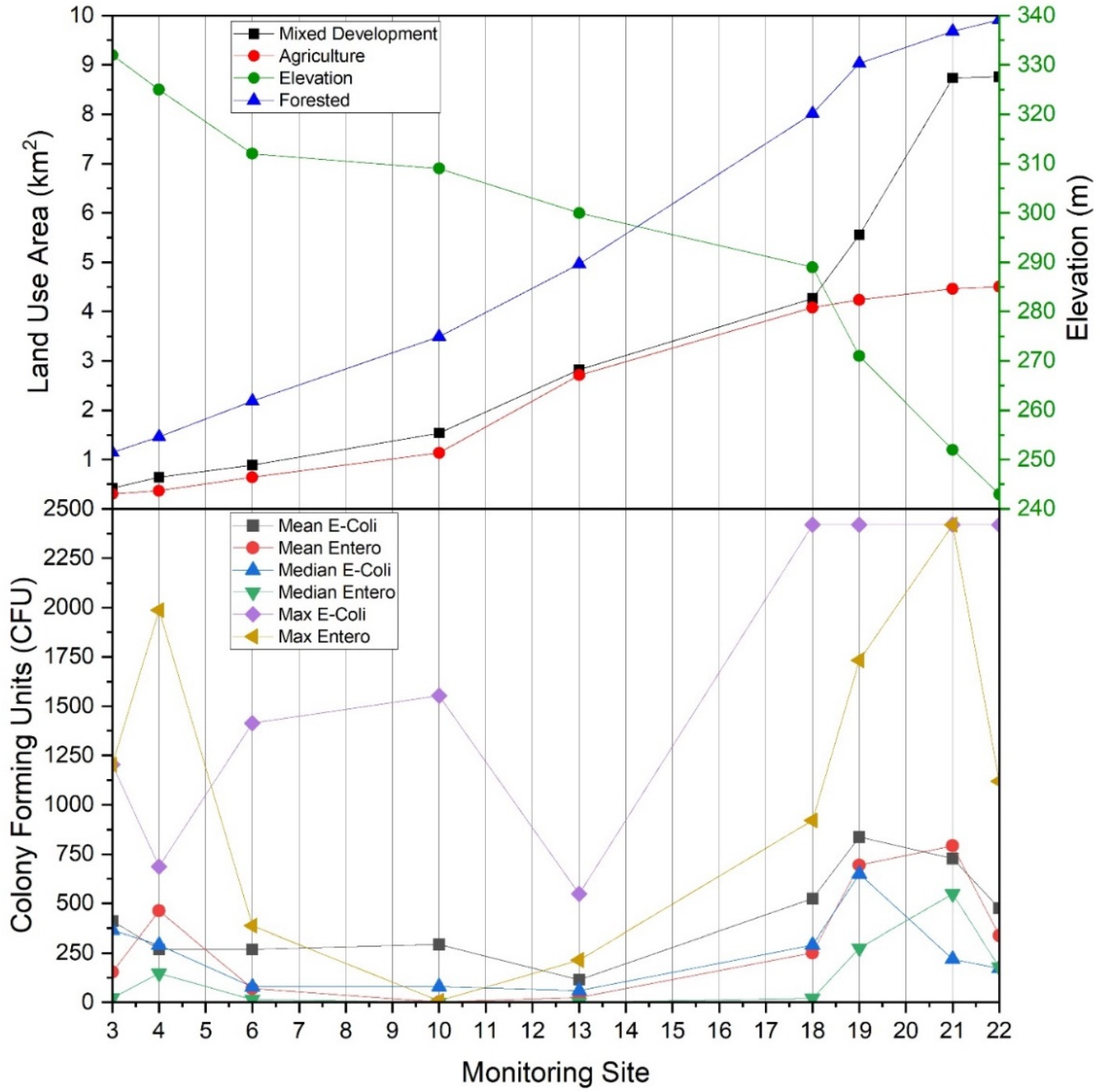
| Site | Mixed Development (%) | Agriculture (%) | Forested (%) | Drainage Area (km²) |
|---|---|---|---|---|
| 1 * | 53.23 | 38.70 | 8.07 | 0.30 |
| 2 * | 13.58 | 12.20 | 74.21 | 0.29 |
| 3 | 22.35 | 16.17 | 61.32 | 1.87 |
| 4 | 25.88 | 14.91 | 59.00 | 2.48 |
| 5 * | 23.35 | 25.51 | 51.14 | 0.38 |
| 6 | 23.91 | 17.25 | 58.70 | 3.72 |
| 7 * | 16.33 | 28.60 | 54.91 | 0.78 |
| 8 * | 30.78 | 16.47 | 52.35 | 1.55 |
| 9 * | 27.57 | 19.33 | 52.84 | 2.29 |
| 10 | 24.92 | 18.40 | 56.49 | 6.18 |
| 11 * | 18.15 | 41.87 | 40.00 | 1.75 |
| 12 * | 31.77 | 33.72 | 34.51 | 1.75 |
| 13 | 26.83 | 25.77 | 47.15 | 10.53 |
| 14 * | 16.19 | 26.43 | 56.92 | 3.36 |
| 15 * | 70.28 | 10.31 | 19.42 | 0.98 |
| 16 * | 5.38 | 58.72 | 35.16 | 0.25 |
| 17 * | 4.78 | 9.38 | 85.84 | 0.75 |
| 18 | 25.98 | 24.88 | 48.86 | 16.41 |
| 19 | 29.45 | 22.45 | 47.85 | 18.88 |
| 20 * | 89.16 | 4.19 | 6.61 | 3.42 |
| 21 | 38.10 | 19.46 | 42.23 | 22.93 |
| 22 | 37.71 | 19.38 | 42.66 | 23.24 |
Publisher’s Note: MDPI stays neutral with regard to jurisdictional claims in published maps and institutional affiliations. |
© 2022 by the authors. Licensee MDPI, Basel, Switzerland. This article is an open access article distributed under the terms and conditions of the Creative Commons Attribution (CC BY) license (https://creativecommons.org/licenses/by/4.0/).
Share and Cite
Hubbart, J.A.; Kellner, E.; Petersen, F. A 22-Site Comparison of Land-Use Practices, E-coli and Enterococci Concentrations. Int. J. Environ. Res. Public Health 2022, 19, 13907. https://doi.org/10.3390/ijerph192113907
Hubbart JA, Kellner E, Petersen F. A 22-Site Comparison of Land-Use Practices, E-coli and Enterococci Concentrations. International Journal of Environmental Research and Public Health. 2022; 19(21):13907. https://doi.org/10.3390/ijerph192113907
Chicago/Turabian StyleHubbart, Jason A., Elliott Kellner, and Fritz Petersen. 2022. "A 22-Site Comparison of Land-Use Practices, E-coli and Enterococci Concentrations" International Journal of Environmental Research and Public Health 19, no. 21: 13907. https://doi.org/10.3390/ijerph192113907






